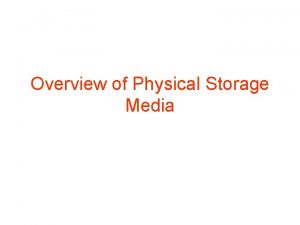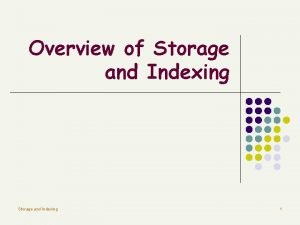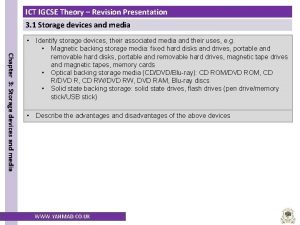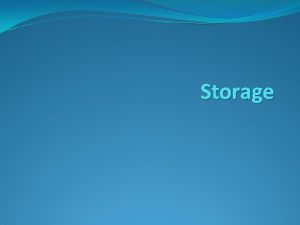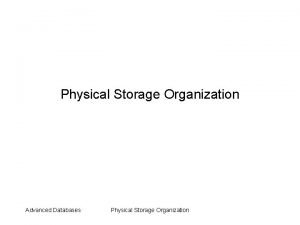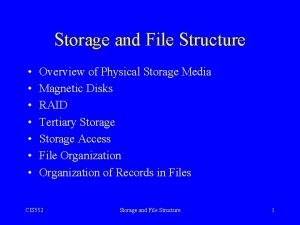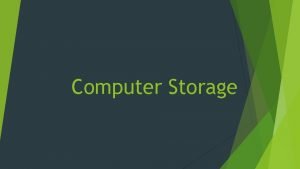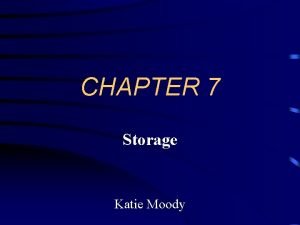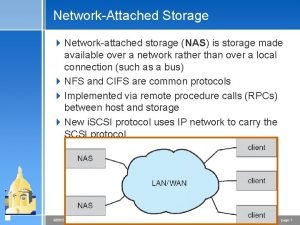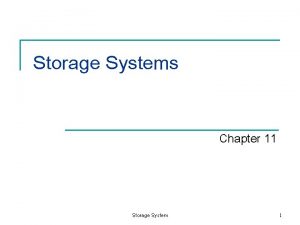Overview of Physical Storage Media Physical Storage Media













- Slides: 13

Overview of Physical Storage Media

Physical Storage Media • Several types of storage medias are exist in computer system. They are classified into different types 1. Accessing speed 2. Cost per unit of data 3. Reliability

Storage Device hierarchy • The various storage media can be organized in a hierarchy according to their speed and their cost. • Cache • Main memory • Flash memory • Magnetic disk • Optical disk • Magnetic tapes

• The higher levels are expensive, but are fast. As we move down the hierarchy, the cost per bit decreases, where as the access time increases. • The storage hierarchy includes 3 main categories. • Primary storage – This category usually provides fast access to data, but has limited storage capacity, it is volatile in nature. • Cache and main memory

• Secondary Storage (on_line storage) – These device usually have a large capacity, less cost and slower access to data. It is non volatile – Eg. Flash memory, magnetic disks. • Tertiary storage (Off_line storage) – This is in the lowest level of hierarchy, nonvolatile, slow access time – Eg: Magnetic tape, optical storage.

Based on storage volatility they can be classified into 2 types • Volatile storage – Loses the contents when the power to the device is removed. • Eg. , Main memory and cache. • Non-Volatile storage – Contents persist even when the power is switched off. • Eg. , Secondary & Tertiary storage devices.

Primary Storage devices • Cache memory – It is the fastest and most costly from of storage. It is volatile in nature. It is managed by computer system hardware. • Main Memory – Fast access, generally two small to store the entire database. – Too expensive – Capacities of upto a few giga bytes widely used currently.

Flash Memory • It is present between primary storage and secondary storage in the storage hierarchy. • It is non volatile memory. • Accessing speed is as fast as reading data from main memory. • Widely used in embedded devices such as digital cameras. • It is also known as EEPROM (Electrically Erasable Programmable Read Only Memory). • Disadvantage is that an entire block must be erased and written over at a time.

Secondary Storage Devices • Magnetic Disk – Primary Medium for long term storage of data, Typically stores entire database. – Data must be moved from disk to main memory for access and written back storage. – Much slower access than main memory. – Capacities ranges upto 400 Gigabytes currently – Much larger capacity than main and flash memory. – Disk storage survives power failures and system crashes. – Disk failure can destroy data but is very rare.

Tertiary Storage • Optical Disks – CD ROM – DVD – CD –R and DVD-R • Magnetic Tapes

• Optical Disks – It is non volatile in nature – Data is read optically from a spinning disk using a laser. – CD-ROM, DVD and Record once versions are most popular from of Optical storage. • CD ROM (Compact Disk Read only Memory) – – Disks can be loaded into or removed from a drive High storage capacity (640 MB per disk) Higher seed times or about 100 mseconds. Higher latency (300 RPM) and lower data transfer rates ( 3 to 6 MB/sec) compared to magnetic disks.

• DVD (Digital Video Disk) – DVD – 5 hold 4. 7 GB and DVD- 9 holds 8. 5 GB – DVD-10 and DVD-18 are double sided formats with capacities of 9. 4 GB and 17 GB – Other characteristics similar to CD-ROM. • Record once Versions (CD-R and DVD-R) are becoming popular – Data can only be written once, and cannot be erased. – High capacity and long lifetime, used for archival storage – Multiple write versions also available (CD_RW, DVDRW)

• Magnetic Tapes – Non volatile memory used mainly for backup, for storage of infrequently used information and as an off-line medium for transferring information from one system to another. – Holds large volume of data and provides high transfer rates – Very slow access time in comparison to magnetic disks and optical – Tape jukeboxes used for very large capacity of storage
 Physical storage devices
Physical storage devices Overview of storage and indexing
Overview of storage and indexing Primary storage vs secondary storage
Primary storage vs secondary storage Storage devices of computer
Storage devices of computer Uses rigid metallic platters
Uses rigid metallic platters Object based and unified storage
Object based and unified storage Ict igcse theory
Ict igcse theory Www overview
Www overview Maximo work order priority
Maximo work order priority Universal modeling language
Universal modeling language Uml
Uml Retail vertical
Retail vertical Figure 12-1 provides an overview of the lymphatic vessels
Figure 12-1 provides an overview of the lymphatic vessels Systemic veins
Systemic veins
